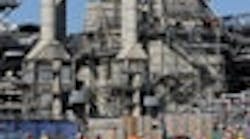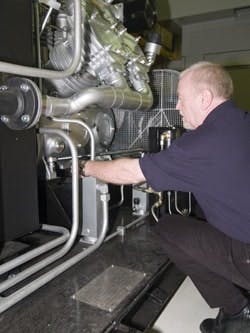Speaking at the International Oil Summit in Paris on May 3rd, Royal Dutch Shell downstream director Mark Williams described last year's opening of the Pearl gas-to-liquid (GTL) plant in Qatar as a significant landmark. "With a total investment of $18–19 billion, it illustrates the scale of infrastructure needed to meet rising demand," he said.
Jointly developed by Shell and Qatar Petroleum, the Pearl GTL plant (Figure 1) is the largest of its kind in the world and takes gas from two unmanned platforms 60 km offshore. It's targeted to produce 1.6 billion ft3/d of gas. Post processing, this will generate 120,000 bbl/d of condensate and natural gas liquids, plus 140,000 bbl/d of products such as chemical feedstocks and lubricants.
The plant also is breaking records when it comes to the demands it made on Atlas Copco Rental, Abu Dhabi.
"Atlas Copco Services Middle East has been mainly involved in the provision of equipment used in the massive pre-commissioning program of the Pearl facility," says Akram Tamari, regional rental manager. "As an example, our oil-free compressors and desiccant air dryers were employed in activities that included air blowing for cleaning, generating instrument air and the pneumatic testing of the fuel gas processing and air separation units. In total, our compressors generated more than 300 million m³ of dry 100%-oil-free air for the project, making it one of the biggest compressor rental projects ever."
"You can imagine that during projects of this size they need compressed air on multiple locations... If they need more flow than expected, the compressors are just a phone call away. That's one of the advantages versus owning equipment," notes Kris Herremans, business development manager, Atlas Copco Rental, Rumst, Belgium.
Regardless of whether a plant requires compressed air for commissioning, a turnaround or to maintain production, reliability is crucial, he adds. "The last thing they want is a breakdown of a rental compressor. That's part of our daily challenges — offering state-of-the-art equipment on a 24/7 basis."
RENT VERSUS BUY
However, air systems auditor Chris Beals, president of Air System Management, Centennial, Colo., says one of the major reasons plants call him in is because they want to eliminate the need for rental equipment.
"Saving energy is a key driver for audits, but clients really want to improve the system reliability and eliminate the need to rent air compressors, especially if they're running on diesel. The fuel cost associated with operating diesel-engine-driven rental compressors is enormous. Audits are often carried out, too, for clients who are faced with adding another air compressor because they don't have enough backup capacity," he explains.
He cites the case of a Texas refinery, where he recommended replacing old heatless dryers with internally heated or blower purge units. This, combined with a couple of demand-side opportunities, would cut demand by 8,000 cfm and allow the company to relegate an existing compressor to backup. "It completely did away with the need to install a new compressor. Yes, you do have to spend a fair amount on the new dryers, but you save both in energy use and rental charges and also improve system reliability. The simple payback was less than 24 months. Bear in mind that the typical rental for a single oil-free compressor (1,600–2,200 cfm) is about $8,000/month and that adding a dryer brings this up to about $12,000/month. And that's without even turning it on."
Rental compressors still may make sense for backup, Beals notes. As an example, he cites another customer that was paying $180,000 annually for rental backup compressors. A new compressor would cost $1.5 million installed; the simple payback was 8.33 years, hardly a strong inducement. On the other hand, for plants regularly operating diesel-engine-driven rental compressors, it's really quite easy to justify the new compressor, he says.
"What I don't understand is the thought process that seems to exist in the petrochemical industry that concludes it's better to spend maintenance money on the rental compressors and fuel year after year rather than spending capital on new compressors, which would reduce annual operating costs," he says.
OTHER OPPORTUNITIES
Beals also points to other areas now attracting industy's focus: on the supply side, centrifugal air compressor and desiccant dryer efficiency, plus system reliability, and on the demand side, leak surveys. Exemplifying this, he currently is conducting a compressed air system review at a major U.S. refinery that will keep him on site for 60 days — his longest audit ever. Beals and his team will conduct a supply- and demand-side review, a leak survey, and flow measurements to each unit.
"Years ago leak surveys weren't considered an essential part of an audit, but companies now appreciate that you can conduct a more in-depth demand-side audit if you carry out a leak survey at the same time. Most clients also supply a person to work with us during the leak survey so they can attempt to repair the leaks as we find them. For example, during a recent refinery audit, the company mechanic working with us repaired nearly 1,000 of the 2,700 identified leaks, which reduced demand by approximately 1,000 cfm."
Such leaks typically are found at filters, regulators, lubricators, air drops and control valves. Isolation valves with single packing nuts also are common culprits.
Another demand-side opportunity for optimization involves air-operated cabinet coolers. Although cheap and intrinsically safe, they often are installed without thermostatic controls. "Almost any plant can install the thermostatic controls and significantly reduce demand — and this is something that is sustainable that they can actually get implemented."
On the supply side, one of the biggest opportunities in most plants is to replace heatless dryers with more efficient dryers — doing so allows users to save energy and recapture air capacity. "While vacuum purge dryers, which are popular in Europe, may be the most efficient dryers, they haven't been able to break into the U.S. market; so, we typically recommend internally heated or blower purge dryers. We don't recommend heat-of-compression dryers because they are typically less reliable and we are often hired to provide justification to replace them," notes Beals.
There also is an argument to be made about the use of trim compressors, he says. In many other industries trim compressors are allowed to load and unload — but not in the chemicals sector, where the philosophy is to keep a constant pressure and maintain online backup capacity.
"The defense for this philosophy is that if the plant is shut down due to a compressed air issue it eats up all the energy savings you could have made and more in just a few hours. Plants are very worried about jeopardizing production, so your recommendations must be based upon sustainable demand reductions, such as installation of internally heated, blower purge or vacuum purge dryers rather than repairing air leaks."
Beals notes that in the last 20 years oil-free centrifugal compressors have become more popular because of their longer intervals between overhauls. To further extend the intervals, some plants now install 125-psi centrifugal compressors but operate them at a lower pressure — accepting reduced efficiency to increase the periods between overhauls.
For the future, Beals sees more plants considering compresssor automation and over-the-fence air. "However, based upon my experience, it is still very hard in the U.S. to get capital for compressed air systems or other utilities until it's absolutely necessary — and this is holding back improvements in compressed air system efficiency."
To help plants achieve optimum cost and energy savings, compressor maker Gardner Denver, Wayne, Pa., offers a ten-point guide: 1) carry out an air audit; 2) specify the correct receiver size; 3) be aware of network pressure; 4) size downstream equipment correctly; 5) perform regular maintenance; 6) conduct weekly checks on downstream filters; 7) use the right technology; 8) don't buy on price; 9) eliminate off-load running; and 10) focus on leak reduction.
HIGH-PRESSURE SOLUTIONS
Gardner Denver notes that chemical and pharmaceutical operations increasingly are installing its Reavell high-pressure compressors and boosters (Figure 2). Typical uses include air and other industrial gas compression, gas recovery systems, inert gas blanketing and cryogenic cooling systems.
"A large part of our business is supplying high-pressure compressors and boosters (up to 6,000 psi/350 hp). The key issue here is sizing: the solution must be suitable for the application," explains Paul Green, sales manager, high pressure products Americas.
"The key is to optimize the available gas pressure and size and to configure the machine to ensure its operating parameters are the most efficient, which ensures not only reliability but keeps operating costs to a minimum," he adds.
A focus on initial capital cost can undermine achieving efficiency and optimization, Green warns. "Many markets are still very conservative and there can be issues with getting customers to accept using higher-speed compressors/boosters despite their advantages, such as less bearing and piston wear, higher reliability and lower maintenance costs."
"Customers do look very closely at the purse strings. But a lot of this depends on where the money is coming from and which people within the company you are actually speaking with. It also depends on how critical the application is. For example, we have been asked to repair broken machines that under normal circumstances might be switched out for new models, but the money was there in the service budget so they were repaired rather than replaced."
In another example, the company replaced a 300-hp compressor that was running at 100% all the time with two 150-hp compressors in a lead-lag configuration. The second machine comes on-line only to meet certain pressure demands; the company involved is saving 30–40% on compressed air energy costs as a result.
"Maintainability is a key factor in looking at 'through life costs' of any piece of equipment and is a key feature of all Reavell products," notes Green. For example, the 100-hp (75-kW) 5,000-psig 100-scfm 5437 model can be totally stripped and rebuilt in a day and a half, he notes; a valve change takes just five minutes and a three- or four-stage piston ring can be replaced in just 15 minutes, he adds.
The high-pressure Reavell products all are oil lubricated but Green believes this isn't the drawback users presumed in the past. "Not all chemical applications necessarily require 100%-oil-free air and, with high-pressure Reavell compressors, they have an oil carry-over of less than 2–3 ppm, which is easily removed with final filters. This is down from 20 ppm only a few years ago and getting even better as a result of new ring materials that don't require the same level of lubrication. So there are definitely cases now where people automatically assume they need oil-free, but in reality the required air purity can be achieved through suitable filtration. And this is an argument that we are winning now," he says.
Seán Ottewell is Chemical Processing's Editor at Large. You can e-mail him at [email protected].




